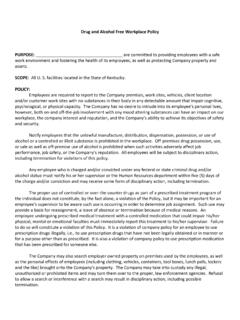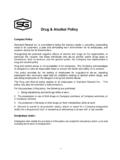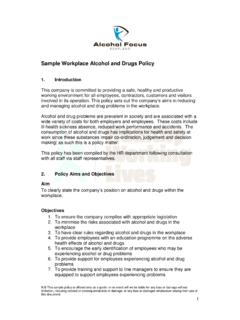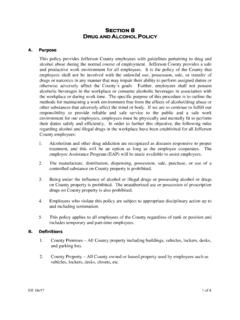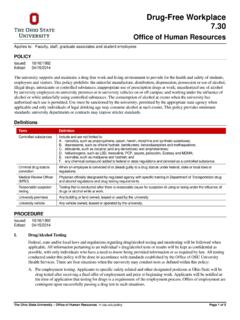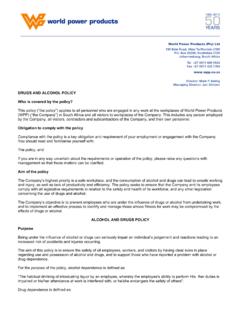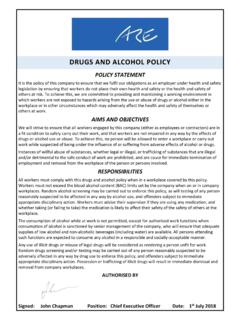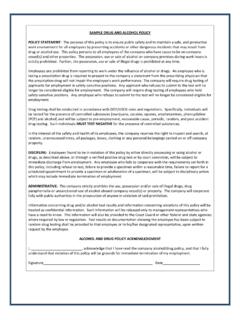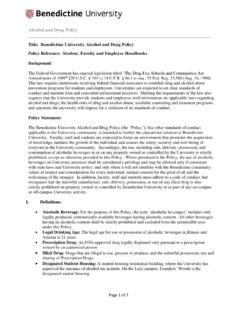Transcription of Drug and Alcohol Policy 2017 - Argosy University
1 drug and Alcohol Prevention Program and the drug -Free Workplace and Campus Program Revised: June 14, 2017 . Standards of Conduct The use of illegal drugs and the abuse of Alcohol on the campus of Argosy University , Dallas or in facilities controlled by Argosy University , Dallas are prohibited by college regulations and are incompatible with Argosy University 's goal of providing a healthy educational environment for students, faculty, staff and guests. The following information is provided in compliance with the drug -Free Schools and Communities Act Amendments of 1989.
2 Effects of Drugs and Alcohol Although individuals often use drugs and Alcohol to achieve a variety of effects on mind and body that are found to be temporarily useful or pleasurable, drugs can be highly addictive and injurious. A person can pay a price in terms of his or her physical, emotional, and social health. This price can be paid in a number of ways. The risk of contracting sexually transmitted diseases, including AIDS, is increased through unwanted or unprotected sex when one is under the influence of drugs or Alcohol .
3 Drugs can be the trigger for violent crime. Economic and legal problems usually follow directly when one tries to support a drug habit by resorting to crime. The dependence, illness, loss of job, and loss of family or friends that can result from drug or Alcohol use and abuse can be tragic. In keeping with the mission of Argosy University and the requirements of state and federal law, Argosy University , Dallas has adopted this program to ensure a drug -free campus and workplace and to prevent the use of controlled substances and the abuse of Alcohol .
4 Health Risks Associated with the Use of Alcohol Short Term Risks: Increased risks of accidents and injuries Alcohol -related traffic accidents (the leading cause of death for teens). Alcohol slows reaction time, decreases muscle coordination, and impairs vision Fatal overdose Unconsciousness or blackout Death by aspiration of vomit Nausea Gastritis Long-Term Risks: Increased blood pressure Increased risk of heart attack Brain damage resulting in permanent psychosis Cancer of the mouth, esophagus or stomach Liver damage (cirrhosis, Alcohol hepatitis, cancer).
5 Ulcers and Gastritis Pancreatitis Birth defects In males-testicular atrophy and breast enlargement In females--increased risk of breast cancer Prolonged, excessive drinking can shorten life span by ten to twelve years. Health Risks Associated with the Use of Drugs Amphetamines (Speed, Uppers): Malnutrition Hallucinations Dependence, psychological and sometimes physical Deliriums (Aerosols, Lighter Fluid, Paint Thinner): Permanent damage to lungs, brain, liver, bone marrow Loss of coordination, confusion, hallucinations Overdose causing convulsions, death Depressants (Barbiturates, Tranquilizers, Methaqualone).
6 Confusion, depression, loss of coordination Dependence, physical and psychological Coma, death (caused by overdose). Can be lethal when combined with Alcohol Hallucinogens (LSD, PCP, DMT, STP, Mescaline): Hallucinations, panic, irrational behaviors (which can lead to increased risk of accidents, injuries). Tolerance overdose leading to convulsions, coma, death Possible birth defects in children of LSD users Intravenous drug Use: Places one at risk for HIV infection (the virus causing AIDS) when needles are shared Marijuana and Hashish: Chronic bronchitis Decreased vital capacity Increased risk of lung cancer In men lower levels of testosterone and increase in abnormal sperm count Stimulants (Cocaine).
7 Painful nosebleeds and nasal erosion Intense "downs" that result in physical and/or emotional discomfort Tolerance and physical dependence can develop Narcotics (Heroin, Morphine, Codeine, Opium): Malnutrition Hepatitis Loss of judgment and serf-control leading to increased risk of accidents, injuries Dependence Overdose leading to convulsions, coma, death Sanctions Argosy University , Dallas School Sanctions Argosy University , Dallas, in all of its actions, seeks to uphold local, state and federal laws. Insofar as permitted by these laws, Argosy University , Dallas will apply sanctions that could lead to a student being suspended or expelled or an employee being disciplined, suspended or dismissed for violation of the Argosy University , Dallas standards of conduct.
8 Students and employees may also be referred for prosecution. Disciplinary sanctions may include the completion of an appropriate rehabilitation program, at the student's or employee's expense, if necessary. State Sanctions Texas criminal statutes provide for drug offense penalties in relation to the nature of the offense, the drug involved, whether the offense is a first or subsequent offense, and in some cases, the amount of the drug involved. Texas Law I. Criminal Penalties: A Class C misdemeanor is punishable by a fine not to exceed $500.
9 A Class B misdemeanor is punishable by a fine not to exceed $2000; confinement in jail for a term not to exceed 180 days; or both fine and confinement. A Class A misdemeanor is punishable by a fine not to exceed $4000; confinement in jail for a term not to exceed one year; or both fine and confinement. A state jail felony is punishable by confinement is a state jail for any term of not more than 2 years or less than 180 days and by a fine not to exceed $10,000. A 3rd degree felony is punishable by imprisonment for any term of not more than 10 years or less than 2 years and a fine not to exceed $10,000.
10 A 2nd degree felony is punishable by imprisonment for any term of not more than 20 years or less than 2 years and a fine not to exceed $10,000. A 1st degree felony is punishable by imprisonment for life or for any term of not more than 99 years or less than 5 years and a fine not to exceed $10,000. II. Offenses: A. Offense of manufacture of delivery of controlled substances Sections , , , and , Texas Health and Safety Code, which vary the offense and punishment based upon two factors: the type of drug (which schedule it is listed under) and the quantity of the drug involved in the offense.

